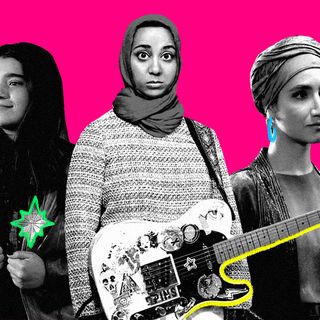
Why Celebrating ‘Brahmastra’ to Save Bollywood From the ‘Boycott Gang’ Is a Flawed Approach
Current filmmaking trends, including Brahmāstra, indicate that the larger workings of Bollywood, and the “Boycott Gang,” are two sides of the same coin.

Ayan Mukerji’s Brahmāstra: Part One – Shiva finally released in theatres last Friday, after eight years of development. The movie, part of a trilogy that in itself is part of a larger cinematic universe, opened to largely negative reviews, with a special focus on the movie’s childish dialogues, simplistic writing, and the lack of any chemistry between the lead pair, played by Ranbir Kapoor and Alia Bhatt. Despite this, however, the movie has done well at the box office so far, crossing the coveted 100 crore mark within three days. This led many to hold the film itself as representative of a larger struggle for Bollywood’s soul. But rooting for its success against its artistic merit is accepting the terms of debate set by those who boycott the industry — and this could end up making things worse.
Many expressed happiness about the fact that people flocked to theatres for a Hindi film after a long time, amidst a constant call from a large section of right-wing accounts on social media to “boycott” every Bollywood film. Often, the grounds for boycotting films are flimsy — ranging from actors’ statements from several years ago, to claims of hurt religious sentiments based on a single still or moment from trailers or songs. Sometimes these are thinly veiled attempts to target actors for their religion. Predictably, Brahmāstra also faced calls for boycott, most famously when Bajrang Dal members refused to let Kapoor, Bhatt, and Mukerji enter a temple citing an old video where Kapoor mentions that he is “a beef guy” who loves to eat the meat.
In this light, Brahmāstra doing good business has led to several people pinning their hopes on the movie’s success for the revival of the theatrical Hindi film industry. Justin Rao, an entertainment journalist at Indian Express Online, uploaded a lengthy, four-part post on Instagram on Saturday where he terms the success of the film as a spark that shows that the “Boycott gang” was simply misrepresenting the lack of quality theatrical releases in Hindi as a growing “anti-Bollywood” sentiment.
However, this assessment of Brahmāstra may be misplaced. The plot of the film is woven around overt Hindu mythology and iconography. The protagonist goes by the name Shiva, who is on his way to collect three pieces of an ancient weapon — that has the potential to destroy the entire world — before an evil army can lay its hand on it. At first glance, there may be nothing wrong with this approach; mythologies offer rich canonical stories for art to draw from. But context matters, and a closer inspection of everything surrounding the film bears scrutiny.
For one, the film is presented by SS Rajamouli — of Baahubali and RRRfame — who has perfected the use of mythology and Hindu nationalist pride in his mega-blockbuster movies. Ritesh Babu in a Vox article describes the Hindutva nationalism of Rajamouli in detail, writing, “…Rajamouli de-specifies and decontextualizes, only to wrap everything up in his casteist status-quo-affirming lens. His work…is a casteist Hindu wash of history and the independence struggle. It’s exactly this kind of convenient upper-caste Hindu viewpoint that helps sustain Hindutva ideology and its material harm.”
Mukerji’s own Instagram is a good exhibit of how the film has tried to constantly cater to the sentiments of Hindu pride to sell the film. Aside from all the direct promotional material, his account is peppered with photos and reels of temple visits. And there is one post where he directly mentions how Kapoor’s character was originally named Rumi. Eventually, the team decided to restructure a lot of elements in the film, and “Rumi became Shiva.”
Related on The Swaddle:
Calls to Boycott ‘Laal Singh Chaddha’ Show How Bigotry Underlies Anti‑Bollywood Sentiments
In multiple videos and public appearances for the film’s promotion, Mukerji has iterated his fascination with Hindu gods and goddesses and ancient Indian philosophy. Renaming 2014’s Rumi to 2022’s Shiva, and Mukerji constantly reminding audiences that he was deeply respectful of Hinduism, point to how the movie has tried to milk for profit a lighter shade of the same majoritarian sentiments that today stand in direct opposition to the existence of the Hindi film industry.
In her review of the movie, film critic Sucharita Tyagi notes that the film is “Hindu and very Hindu. No other religion exists in this wide, wide universe.” She explains that “it wouldn’t have been such a glaring issue if the film wasn’t as religious as it is.” The first song released from the film was titled Kesariya or saffron, a color close to the Hindu right. In a way, then, the movie doesn’t just borrow from Hindu mythology but also uses the mythology and iconography to pander to a soft Hindutva vision. These are themes worth unpacking and critically examining — but the tug of war between those who call for its boycott and those who don’t frames the film in black and white terms and glosses over nuances worth discussing.
Brahmāstra, then, most prominently points to how the politics of majoritarianism has dictated the norms of filmmaking under the current regime. Rooting for its success doesn’t go against the “boycott gang” as they’ve been called — in fact, it bolsters their vision of the direction that filmmaking in India should pivot to.
Brahmāstra of course is not the only Hindi film that tries to fit into the current climate of majoritarianism. This year’s highest-grossing Hindimovie so far is Vivek Ranjan Agnihotri’s The Kashmir Files, a film that was called out for its misleading, islamophobic portrayal of the 1990 Kashmiri Pandit Exodus which later led to violent hate crimes and riots against Muslims in other parts of the country. Films like Uri: The Surgical Strike (2019), Tanhaji: The Unsung Warrior (2020), and Sooryavanshi (2021) also made robust money in the past. Writing about Sooryavanshi in The Washington Post, Rana Ayyub mentions that “Islamophobic tropes are the center of the film…Every third frame of the film is a bloodcurdling Islamophobic image.” Like Brahmāstra, Sooryavanshi was also produced by Karan Johar.
Other films, too, have tried to cater to the same sentiments but haven’t succeeded at the box office. Aanand L Rai’s Rakshabandhan is a recent example, which stars Akshay Kumar as a man worried about his duty of marrying off his four sisters, along with arranging adequate dowry to send them off. Chandraprakash Dwiwedi’s Samrat Prithviraj is another, (again) starring Akshay Kumar as the titular Rajput king often held in high regard by upper-caste Hindu right-wing groups. Some Hindi films currently in development include biopics of Sher Singh Rana — the assassin of Phoolan Devi, and of Vinayak Damodar Savarkar, a Hindu nationalist who first developed the political ideology of Hindutva.
It is unlikely that the success of Brahmāstra will affect the calls to boycott the film, or stall the trajectory of future films — especially those starring Muslim actors in the lead or that actively promote Hindutva ideologies. In other words, it won’t change an atmosphere that’s already been set in place — which in turn makes it unlikely that Bollywood will stop catering to majoritarian trends and sentiments.
Of course, audiences may like or dislike a movie for multiple other reasons than just its political content or its shoddy technique. Sometimes, a particular film may attract audiences because of other factors such as its visual brilliance, ensemble cast, or music. At times, people may just want to look at their favorite stars on the big screen. However, portraying a film’s success on these counts as a moral victory over forces that the film industry has helped fuel may prevent introspection into both the legitimate criticisms of the movie and the larger workings of the industry itself.
Amlan Sarkar is a staff writer at TheSwaddle. He writes about the intersection between pop culture and politics. You can reach him on Instagram @amlansarkr.
Related


The Buzz Cut: Amid Catastrophic Weather Events, Man’s Saliva Becomes Matter of International Concern
